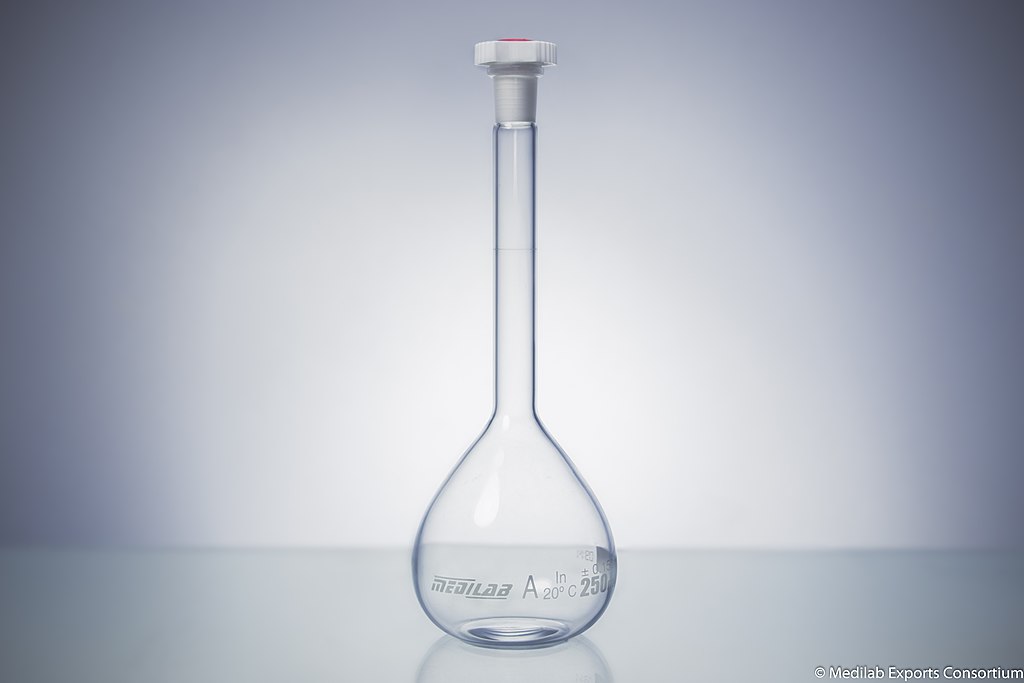|
Target: 10 Questions in 10 minutes
An IB Chemistry data booklet is helpful |
|||||||||||||||||
1. What is the concentration of a solution (in mol dm-3) which contains 4.00g of sodium hydroxide, NaOH, in 500cm3 of solution?
| |||||||||||||||||
2. Which solution contains the greatest number of moles of ions?
|
|||||||||||||||||
| 3. What mass of solid is required to produce 200cm3 of a standard sodium carbonate solution, Na2CO3, of concentration 0.100 mol dm-3?
|
 Random104 CC-BY-SA 4.0 |
||||||||||||||||
| |||||||||||||||||
| 4. What volume, in cm3, of 0.50 mol dm-3 KOH is required to neutralize 0.010 mole oxalic acid?
C2H2O4(aq) + 2KOH(aq) → K2C2O4(aq) + 2H2O(l)
| |||||||||||||||||
5. 25.00cm3 of 0.0146mol dm-3 sodium hydroxide solution, NaOH, reacted exactly with 10.35cm3 of phosphoric acid solution, H3PO4.
| |||||||||||||||||
| 6. A precipitate of aluminium hydroxide was produced by the following reaction:
Al2(SO4)3(aq) +6NaOH(aq) → 2Al(OH)3(s) + 3Na2SO4(aq) How many moles of aluminium hydroxide were formed when 200cm3 of 2.0mol dm-3 of aluminium sulfate solution and 800cm3 of 1.5mol dm-3 of sodium hydroxide solution were mixed?
| |||||||||||||||||
7. A solution containing iron(II) ions required 8.20cm3 of 0.010mol dm-3 acidified potassium manganate(VII) solution, KMnO4, for complete reaction. The ionic equation for the reaction is: 5Fe2+(aq) + MnO4-(aq) + 8H+(aq) → 5Fe3+(aq) + Mn2+(aq) + 4H2O(l) What amount (in moles) of iron(II) ions was contained in the sample? |
 |
||||||||||||||||
| |||||||||||||||||
8. 0.50 moles of ammonium iron(II) sulfate hexahydrate, (NH4)2Fe(SO4)2.6H2O was dissolved in water to produce 2.0dm3 of solution. What is the concentration (in mol dm-3) of ammonium ions in the solution?
| |||||||||||||||||
| 9. 0.2 moles of barium chloride solution were reacted with 0.3 moles of copper(II) sulfate solution in the following precipitation reaction:
BaCl2(aq) + CuSO4(aq) → BaSO4(s) + CuCl2(aq) Which reactant is limiting and how many moles of copper(II) ions will remain in solution at the end of the reaction? |
|||||||||||||||||
| |||||||||||||||||
| 10. An ethanoic acid/sodium ethanoate buffer solution was made by adding 25cm3 of 0.10 mol dm-3 sodium hydroxide solution, NaOH, to 25cm3 of 0.20 mol dm-3 ethanoic acid, CH3COOH.
CH3COOH(aq) + NaOH(aq) → CH3COONa(aq) + H2O(l) What was the concentration (in mol dm-3) of ethanoic acid in the final buffer mixture?
|
|||||||||||||||||